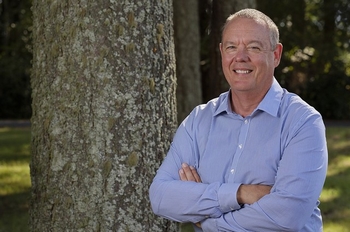Leading the big conversations

Evidence-based thought leadership is a key role of a Crown research institute. It’s about contributing to industry and policy makers’ conversations with original, evidence-based perspectives. It’s about equipping decision-makers with the insights to help make sound and robust resolutions, and it’s about sharing fact-based narratives about the future.Delivering on this role gives CRIs a valuable voice in the big conversations affecting our country and its people.
Scion’s core purpose is to drive innovation and growth in New Zealand businesses, with a span of influence that is increasingly expanding as consumers are seeking sustainably produced goods with a good end-of-life solution. For us, therefore, it is critical that our thought leadership is followed up with tools, developments and technologies that support good decisions and get taken up by business.
To do this well, we must always take a wide picture view in assessing potential benefit or impact that could be achieved – short term and long term. We took this approach with our wood energy industrial symbiosis project (described in the story 'Wood processors working together for energy efficiency') which used a tool – the Woodscape model – to map new opportunities in regional New Zealand for industrial clusters that collaborate to share resources, energy, by-products and value. Regional benefits include commercial growth and job creation.
This wide picture view is behind our drive for a new decentralised model for bioproduct manufacturing in New Zealand. Mobile manufacturing can make this happen, and Scion’s extrusion technology is an example (see 'Mobile manufacturing'). The ability to take equipment to biomass resources can develop processing in the regions, which provides new skilled employment among other benefits.
We see it as critical that our thought leadership strongly endorses the big picture approach so that we can identify not only opportunities but also gaps in how things might be implemented. With more than 70 years of science, research and development backing us, we firmly believe we must enable New Zealand to move from a non-renewable petrochemical based economy to one using biological processes and renewable materials from planted forests. This is what we mean by the bioeconomy, and the circular bioeconomy is intrinsically linked to the bioeconomy as the waste or residuals from one process becomes the feedstock for another.
To bring the bioeconomy narrative to life we are investing in developing our Rotorua campus as a place where we can showcase and demonstrate research and technological innovations that enable the circular bioeconomy.
We are attracting significant interest from new entities to co-locate with us and participate in our soon-to-be-constructed Innovation Hub. We aim to create a ‘destination’ facility that will open our campus to broader communities, including the public, and to drive more interactions around ideas, opportunities and implementation. To successfully achieve this aim, we recognise that in addition to architectural design to heighten interactions on the campus we will need to design programmes that encourage dynamic connections and also foster a culture of exchange and excitement.
Our new strategy “Right tree, right place, right purpose” has set our path, our campus developments are creating the scene and our talented staff are energising the discussions. I look forward to the big conversations ahead.
I welcome your thoughts on this topic and any other matters raised in this issue of Scion Connections.

Dr Julian Elder
Chief Executive
For further information contact
Dr Julian Elder
